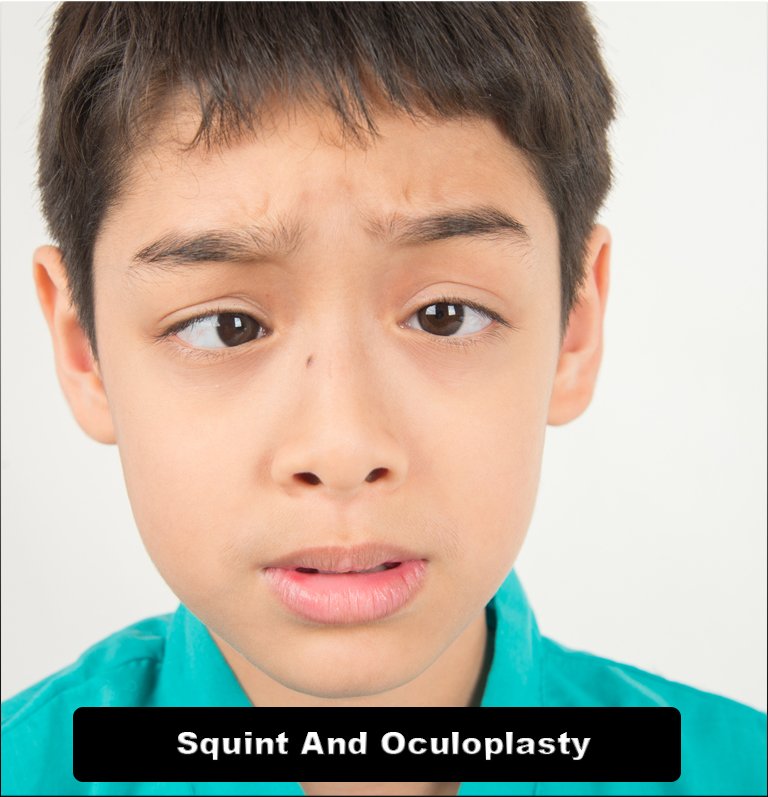


Squint, also known as strabismus, is a condition characterized by misalignment of the eyes, where they point in different directions. This misalignment can be constant or intermittent and may affect one or both eyes. It can occur in children and adults and can have various causes, including problems with the eye muscles, nerves, or brain.
Oculoplasty, on the other hand, is a specialized branch of ophthalmology that focuses on the diagnosis and treatment of disorders related to the structures around the eye, including eyelids, tear ducts, orbit (eye socket), and facial aesthetics. Oculoplastic surgeons are trained to perform both functional and cosmetic procedures to address these issues.
Squint and oculoplasty often intersect as they both deal with aspects of eye health and functionality. In cases where squint is caused by abnormalities in the muscles or structures around the eye, oculoplastic surgeons may be involved in the management and treatment process.
Treatment for squint may involve various approaches depending on the underlying cause and severity of the condition. These can include:
Corrective lenses: In some cases, wearing glasses with special lenses can help correct the alignment
of the eyes.
Eye exercises: Certain exercises may be prescribed to strengthen the eye muscles and improve
coordination between the eyes.
Orthoptic treatment: This involves a combination of exercises and other techniques performed under
the guidance of an orthoptist to improve eye alignment and coordination.
Surgery: In cases where non-surgical methods are ineffective or inappropriate, surgery may be
recommended to adjust the length or position of the eye muscles and correct the alignment of the
eyes.
Oculoplastic surgery may also be recommended to address cosmetic or functional issues related to the
eyelids, tear ducts, or orbit that may be contributing to or associated with the squint.
Overall, both squint and oculoplasty aim to improve the function and appearance of the eyes,
enhancing the quality of life for individuals affected by these conditions. Treatment plans are
tailored to each patient's specific needs and may involve a multidisciplinary approach involving
ophthalmologists, orthoptists, and oculoplastic surgeons.

You can protect your eye health and potentially slow the process of cataracts by: Not smoking, Protecting your eyes from the sun, Getting regular eye care, and Wearing sunglasses and a hat with a brim to block ultraviolet sunlight.

Corneal disease, also known as ocular surface disease, is a group of serious conditions that can affect the cornea. These conditions can cause the cornea to become distorted, clouded, or scarred, and can even lead to blindness.

Refractive surgery is an optional eye procedure that improves the eye's refractive state and can reduce or eliminate the need for glasses or contact lenses . It can involve reshaping the cornea, implanting a lens, or replacing the lens.

The retina is the light-sensitive layer at the back of the eye that receives light and converts it into chemical energy. The uvea is the middle layer of the eye between the retina and the sclera (white part of the eye). The uvea is made up of three parts !

Emphasizes fruits, vegetables, whole grains, and fat-free or low-fat milk and milk products.

There are many variations of passages of Lorem Ipsum available, the majority have suffered alteration

There are many variations of passages of Lorem Ipsum available, the majority have suffered alteration
Refractive surgery can correct refractive errors like nearsightedness, farsightedness, astigmatism, or presbyopia. Some of these surgeries reshape the cornea. Others implant a lens in your eye. Either way, the goal is the same. These surgeries focus light correctly on the retina so you can see more clearly.


Pediatric ophthalmology is a subspecialty of ophthalmology that concentrates on treating the various eye problems affecting children. Studies show that a lot of Attention Deficit Hyperactivity Disorder (ADHD) and learning issues in children can be attributed to vision problems.